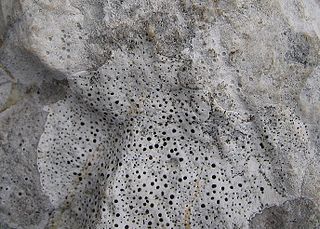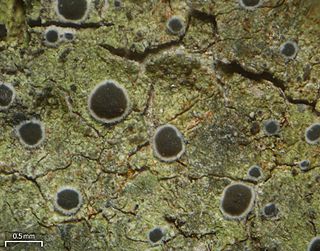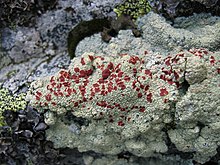
Lobaria is a genus of foliose lichens, formerly classified in the family Lobariaceae, but now placed in the Peltigeraceae. They are commonly known as "lung wort" or "lungmoss" as their physical shape somewhat resembles a lung, and their ecological niche is similar to that of moss.

Verrucariales is an order of ascomycetous fungi within the subclass Chaetothyriomycetidae of the class Eurotiomycetes. Although most of the Verrucariales are lichenised, the family Sarcopyreniaceae consists of 11 species of lichenicolous (lichen-dwelling) fungi.

Pilophorus is a genus of lichenized fungi in the family Cladoniaceae. They are commonly known as matchstick lichens. The genus has a widespread distribution, especially in temperate regions, and contains 11 species.

Byssoloma is a genus of leaf-dwelling lichens in the family Pilocarpaceae.

Pyxine is a genus of foliose lichens in the family Caliciaceae. The genus has a widespread distribution in tropical regions.

Endocarpon is a genus of saxicolous (rock-dwelling), crustose lichens in the family Verrucariaceae. The genus was circumscribed by German bryologist Johann Hedwig in 1789.

Thelidium is a genus of lichen-forming fungi in the family Verrucariaceae. The genus was circumscribed in 1855 by Italian lichenologist Abramo Bartolommeo Massalongo, who assigned Thelidium amylaceum as the type species.

Hypogymnia is a genus of foliose lichens in the family Parmeliaceae. They are commonly known as tube lichens, bone lichens, or pillow lichens. Most species lack rhizines that are otherwise common in members of the Parmeliaceae, and have swollen lobes that are usually hollow. Other common characteristics are relatively small spores and the presence of physodic acid and related lichen products. The lichens usually grow on the bark and wood of coniferous trees.

Bulbothrix is a genus of lichen-forming fungi in the family Parmeliaceae. This genus is synonymous with Bulbothricella V.Marcano, S.Mohali & A.Morales. Bulbothrix was circumscribed by lichenologist Mason E. Hale in 1974 with Bulbothrix semilunata as the type species.

Lecidella is a genus of crustose lichens in the family Lecanoraceae.

The Ophioparmaceae are a small family of lichen-forming fungi in the order Umbilicariales. The family was circumscribed in 1988 by lichenologists Roderick Westgarth Rogers and H. Thorsten Lumbsch.

Porpidia is a genus of crustose lichens in the family Lecideaceae.

Thamnolia is a genus of lichens in the family Icmadophilaceae. Members of the genus are commonly called whiteworm lichens.

Anzia is a genus of foliose lichens known as black-foam lichens in the large family Parmeliaceae. It was formerly included in the monogeneric family Anziaceae, but this has since been subsumed into the Parmeliaceae.

Bryoria is a genus of lichenized fungi in the family Parmeliaceae. Many members of this genus are known as horsehair lichens. The genus has a widespread distribution, especially in boreal and cool temperate areas.
Sulzbacheromyces is a genus of basidiolichens in the family Lepidostromataceae. The genus is distinguished from the other genera of Lepidostromataceae by having an entirely crustose thallus and from Multiclavula (Cantharellales) by having a chlorococcoid photobiont. The type species grows on soil in the neotropics.
Bryoria hengduanensis is a species of lichen of the genus Bryoria. It was described as new to science in 2003 by lichenologists Li-Song Wang and Hiroshi Harada. It is found in the Hengduan Mountains of southern China, where it grows on twigs and branches in coniferous forests at elevations of 3,000–4,000 metres (9,800–13,100 ft). The Hengduan Mountains is a region of high Bryoria biodiversity, as 24 species are known from this area.

Herpothallon is a genus of crustose lichens in the family Arthoniaceae. It has about 50 species.
Placolecis is a genus of lichen-forming fungi in the family Catillariaceae. It has four species of saxicolous (rock-dwelling) and crustose lichens. The genus was circumscribed by Italian botanist Vittore Benedetto Antonio Trevisan de Saint-Léon in 1857. He did not assign a type species for the genus. Josef Hafellner designated a lectotype for Placolecis balanina in 1984, but subsequently, this taxon was folded into P. opaca.
Anzia pseudocolpota is a species of corticolous (bark-dwelling), foliose lichen in the family Parmeliaceae. Found in southwestern China, it was formally described as a new species in 2015 by Xin-Yu Wang and Li-Song Wang. The type specimen was collected by the second author from Lidiping mountain at an altitude of 3,350 m (10,990 ft), where it was found growing on Loranthus bark. It is named for its similarity to Anzia colpota, from which it differs by the presence of a central axis, a discontinuous spongiostratum, and the presence of the lichen product divaricatic acid. The lichen is only known to occur in Sichuan and Yunnan, at elevation ranges between 2,500 and 3,700 m.
















